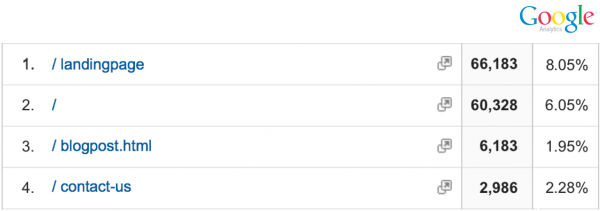 In order to prioritize your conversion optimization plan, we need to prioritize how to begin your A/B testing strategy. In order to do this, we need to figure out where what and why. Understanding the where what and why will help you prioritize the most important areas of opportunity on your website. In this post, I will show you how to find the where to start optimizing your website.
In order to prioritize your conversion optimization plan, we need to prioritize how to begin your A/B testing strategy. In order to do this, we need to figure out where what and why. Understanding the where what and why will help you prioritize the most important areas of opportunity on your website. In this post, I will show you how to find the where to start optimizing your website.
Where? First, start by understanding your top traffic pages, the pages that people are visiting directly from all referral sources. We want to understand where the most opportunities are in order to start optimizing for the most traffic and largest benefit. Start with your best-selling items, test and learn from those tests, and then possibly duplicate those efforts to other areas in other products.
In order to determine where to start testing, we follow Pareto Principle. The Pareto Principle states that for many events, roughly 80% of the effects come from 20% of the causes. Almost every website is broken up into the 80-20 rule – you’re making 80% of your revenue off of 20% of your inventory. That’s the case if you have an eCommerce website. If you have a regular blog or lead generation website, while different, this could also be very similar.
The same thing works for your traffic patterns. You’re making 80% of your traffic off of 20% of your pages. Understanding these top pages, that 20%, is your biggest area of opportunity to start optimizing, start improving, and start growing whatever objectives you have. These objectives could be sales, leads or any other priorities in your company. Understanding that 20% is really where the largest opportunity area lies.
To find out where to start testing, we’ll use quantitative tools, such as Google Analytics, to collect the quantitative data. Quantitative data is all about numbers and metrics. It’s the analytics and the goals that are calculated from your marketing efforts. In the case of a normal e-commerce site, they’re probably making 80% of their revenue off of 20% of the inventory. That 20% is their best-selling items. If they are low-priced items, you want to try to find ways to sell more of those and influence people to buy quicker items.
In Google Analytics, there’s a specific report that can help guide your testing strategy: the Landing Page report (Behavior > Site Content > Landing Pages). These are the pages that people visit directly first. More than likely, one of the top ten pages is going to be your home page. There may also be five to ten other pages also generating enough traffic that you can really optimize too.

Once you understand your top traffic pages, you can figure out where the most opportunities are in that handful of pages. What pages have the highest bounce rate? Which pages are driving the most traffic but have the lowest conversion rates? Which pages are driving the most revenue? Which pages are having the most impact for you to start optimizing? These important questions will help you start isolating the experiences and look at the areas that hold the biggest opportunities. Not only will you have enough traffic to actually change different elements and see an impact, but you’ll also be able to see more results in a shorter period of time. Having enough traffic is very important to actually running A/B tests, and you may not be able to run a test with minimal traffic. There are some specific ways that you could still optimize on low traffic websites, and we’ll talk to that in later posts.
By understanding the Pareto Principle, and applying it to your website and quantitative data, you now have a better understanding of where to start testing. If your site has enough traffic to actually start testing and optimizing, this is where you should start. The 80-20 rule represents your top traffic pages, the pages that are driving the most clicks, visits, and potential revenue. That will help you prioritize where to start testing.
In future blog posts, I’ll also talk about what you should be testing on those pages, how you can understand exactly where people are going on those pages and then start testing from there. We’ll also look at the why. Why are people doing things you want them to do or not? Why are they converting? Why are they not converting? Why are they entering their email address or not? That is the missing piece. We’ll be talking about that in later upcoming blog posts.
View more posts about Conversion Rate Optimization.
Ready to take the next step toward accelerating KPI growth?
Get a complimentary evaluation of your digital experience strategy…

